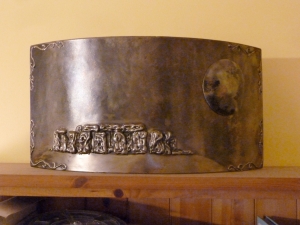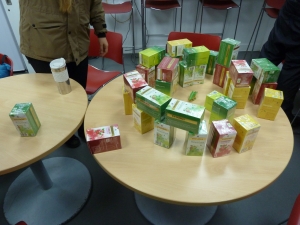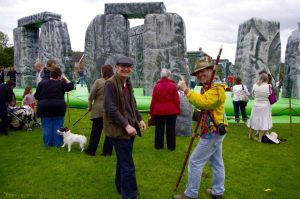
Simon Banton and a rook at an undisclosed location, photo by Wendy Pallesen or perhaps Carol Druce
“…there’s something about the trilithon form that aches with antiquity and latent symbolism.”
Here is the second half of our interview with Stonehenge man Simon Banton.
5) Why do you think so many people continue to make Stonehenges of all sizes and materials all over the world?
The act of creation lies deep within most of us, and creating a clonehenge seems to foster a deep sense of satisfaction. It has the huge advantage of being instantly recognisable, so no special talent is required. I can’t draw for toffee, but you were kind enough to feature my Etch-a-Sketched clonehenge [see previous post] even though it was 2D. There’s also the growing awareness that there’s a community of clonehengers, and I guess a desire to belong to this elite club must factor in somewhere.
[Editor’s note: You, too, can belong to an elite club!]
6) Why do you think Stonehenge models and replicas so often wind up being an assemblage of trilithons rather than being more like Stonehenge? Why is the trilithon such a powerful and memorable symbol?
That is a very significant question. There’s no doubt that “two uprights and one horizontal” is immediately Stonehenge and it’s been a famous icon in the public’s attention for at least 300 years now. From the standalone pylons of Egyptian temples, through the Temple of the Sun at Tiwanaku to the Greek letter PI [Editor’s note: one could add the Japanese Torii gate and Tonga’s Ha’amonga’a Maui Trilithon.] there’s something about the trilithon form that aches with antiquity and latent symbolism.
Perhaps it’s the “doorways upon doorways” meme that Henry of Huntingdon came up with in the early 12th Century AD [Editor’s note: English scholar Henry of Huntington wrote in 1130, describing Stonehenge as a place “where stones of an amazing size are set up in the manner of doorways, so that one door seems to be set upon another. Nor can anyone guess by what means so many stones were raised so high, or why they were built there.”] that’s the root of it for our culture, or maybe Spinal Tap have had a fundamental impact on humanity that will echo down the ages.
I also think that the idea of a continuous “ring beam” [Editor: Simon is using the term “ring beam” here to refer to the continuous circle of curved lintels that is thought to have topped the upright sarsens of Stonehenge’s outer circle.] doesn’t figure in many people’s consciousness, so they end up doing a ring of separate trilithons instead.
7) Is there anything you would like to say about Stonehenge replicas? Do you have any stories connected with one that you would like to share?
More full size ones please! I realise that’s a big ask, but perhaps it’s something for an ice sculpture festival to tackle. I’ve had a small involvement with one full size trilithon replica with my friends Tim Daw and Julian Richards. Julian’s an archaeologist and Stonehenge obsessive. Back in the 1990s he made a TV documentary called “Secrets of Lost Empires” where he and a team of engineers and volunteers attempted—successfully —to erect two 40 ton concrete uprights and a 10 ton lintel as a replica of the tallest trilithon that ever stood at Stonehenge.
After the programme, the components were dismantled and stored on a nearby military base, in a car park, until a few years ago when the army rang him up and asked if he wanted them back as they were getting in the way of their tanks. Julian asked me if I knew anyone who had some land where they might be moved to, and perhaps re-erected in a new project—and I immediately thought of Tim.
Tim’s a visionary. He built the first new “long barrow”, as a columbarium, in 5,500 years and has spawned an industry of modern barrow-makers as a result. [see Clonehenge’s post on the Long Barrow at All Cannings here] He jumped at the chance and these large lumps of concrete were low-loaded from the military base to Tim’s farm, where they await the attention of an intrepid bunch of Stonehengineers. [see Clonehenge’s post about the rediscovery and moving to Tim’s farm of the pieces of the concrete trilithon here]


photos of the parts of the concrete trilithon at rest on Cannings Cross Farm

Stonehengineers, those who helped erect the concrete trilithon the first time
8) Is there anything you think more people should know about Stonehenge itself?
Everyone who’s interested in the astronomy of the site should read Gordon Freeman’s “Hidden Stonehenge”—not least because he is one of the few archaeoastronomer researchers who actually spent considerable time on-site observing and photographing at key points in the year, over many years. He identified a secondary solstitial axis that runs from Winter Sunrise to Summer Sunset and explains why the Altar Stone is (a) flat on the ground and (b) at 80° to the primary axis. I helped Gordon confirm some of his observation data and had the pleasure of meeting him a few years ago.
More generally, the most recent research is suggesting that the society responsible for Stonehenge’s construction was almost completely eradicated by an incoming population from the Continent in the early Bronze Age. If this is true, then we have—in Britain—no direct ancestral connection to the builders of it. That’s something of a shock, as Stonehenge is a touchstone of British identity. The argument about the DNA evidence from early Beaker graves that suggests this is likely to get quite heated.
9) Do you have any advice for hengers?
If you’re going for realism, don’t forget the Heel Stone, the Slaughter Stone, the Station Stones and the Altar Stone. Note that the central trilithons increase in height towards the southwest and they’re all taller than the sarsen circle that surrounds them. If you’re going to include figures in the middle, make them archaeologists having a fight and—above all—think BIG and have fun! (Hengers, take heed!)
10) Do you have any advice for Clonehenge itself?
Frankly, I don’t think it could be any better. [!!!] Except, maybe—Clonehenge merchandise? I feel the need to make a Clonehenge out of Clonehenge coffee mugs—or is that too much like meta-henging?
[Editor: Not at all. Plus, meta-henging is a good thing! 😉 We will be working to make Clonehenge mugs and perhaps eventually other merchandise available from print-on-demand sites in both in the UK and the States, so that neither place will have to pay exorbitant postal fees, hopefully some time in the near future.]
Thank you very much, Simon! Thus ends our two-part interview with the illustrious Stonehenge devotee. We hope you have enjoyed it and perhaps learned something! You can find the first part of the interview here. We should note with gratitude that upon the occasion of our visit to Stonehenge in 2015, Simon went out of his way to meet us there and give us a calendar with his own photos of Stonehenge. We were quite honoured!
Gentle Readers: Do you have questions about Stonehenge or about Stonehenge replicas in any form? If you have a question that is in any way connected to our topic, get in touch on Facebook or Twitter, or leave a comment below, and we will answer or get in touch with someone who can answer your questions. We will also consider requests for posts on related topics.
And of course, until next time, friends, happy henging!



 (Just ignore the show-off bustard. Apparently bird tourists are permitted inside the circle of the ditch and bank, unlike the rest of us that day. Not fair, but as they say, what is?)
(Just ignore the show-off bustard. Apparently bird tourists are permitted inside the circle of the ditch and bank, unlike the rest of us that day. Not fair, but as they say, what is?)
 create these casts as souvenirs to sell in their shop in
create these casts as souvenirs to sell in their shop in 
 but these bricks were the ones that used to line the edge of the visitor path around the monument, and I acquired them when they were torn up as part of the refurbishing of the path back in 2013. I did once make a trilithon out of snow, which is a whole lot trickier than you’d think, and then there was the 5-minute “boxes-of-herbal-tea-henge”, which was a joint effort with other members of the Stonehenge staff when management somewhat over-ordered one day 🙂
but these bricks were the ones that used to line the edge of the visitor path around the monument, and I acquired them when they were torn up as part of the refurbishing of the path back in 2013. I did once make a trilithon out of snow, which is a whole lot trickier than you’d think, and then there was the 5-minute “boxes-of-herbal-tea-henge”, which was a joint effort with other members of the Stonehenge staff when management somewhat over-ordered one day 🙂
 The most impressive has got to be
The most impressive has got to be